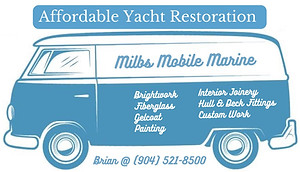
9610 Commonwealth Ave., Jacksonville, FL 32220
Interior Fiberglass Repair Pt. 3 (12-30-24)
Dec 30, 2024
Good progress is being made on the interior repairs to the molded fiberglass liner. Arriving back at the shop, I got straight to work on these repairs. I removed the peel ply from the second glass layup on the forward repair areas and the single, but larger, layup on what I am calling the "engine pan". As expected on the engine pan, some of the glass ran out over the edges of the areas designated for new lamination - not an issue as some feathering of the edges were required. I was happy with the work, after looking things over, and so got to work with my usual post-epoxy chores: water-washing and scrubbing (Scotchbrite pad) the areas that were not covered with peel ply, and then solvent washing the surfaces.
With the post-epoxy chores completed, I grabbed the small Makita 9031 belt sander, as well as some sanding disks to use for hand-sanding work. I started on the engine pan, using the small belt sander, and removed the overruns, blending, and generally prepping for fairing filler. The inside corners just forward of the cockpit floor supports were the most difficult areas to access with the belt sander, and weren't much easier by hand given the cramped quarters. I vacuumed as I went, ensuring that dust was kept to a manageable level.
I moved forward upon completing the engine pan area, starting on the interior locker to starboard. Again, I used a combination of the small belt sander and some hand work. The exterior vertical surfaces of the molded fiberglass liner were next - the area in which typically stores a portable head; and then the interior of the port locker and forward locker followed. I also sanded the small amount of filler I applied to the port-side thru hull repair, prepping for a round of final fairing.
Fairing was my next step for the day, and to that end I thoroughly vacuumed and solvent-washed the surfaces in preparation for additional epoxy work. Once the surfaces were clean, I set out to the shop to mix a couple pots of fairing compound. In this instance, I chose to use a combination of 406 colloidal silica and 410 micro-light to thicken the West System epoxy resin. Since there did not appear to be low spots over ~1/16th of an inch, nearly fair was what I was observing, I chose the lighter 410 material. There will be more rounds of fairing, but this was what I felt I should start with. I applied the fairing compound with a couple different sized plastic squeegees and the rounded-over end of a tongue depressor (the indispensable stir stick!), and occasionally used a finger to blend. I purposefully overfilled areas knowing that hand-sanding would be required to achieve great results.
Total Hrs: 3.5















